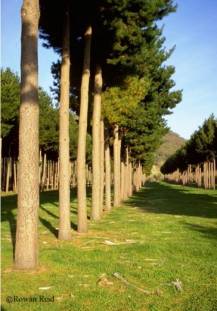|
|
|
Strategies to reduce the risk of fire
damage

There are many ways in which forest owners
can reduce the probability of fire and/or the intensity of
fire if it occurs. Many of these measures are easily incorporated
into forest design and management, and may therefore be very
cost effective. Depending on the situation, landowners might
be able to integrate their tree growing operations into their
farming systems so as to virtually eliminate fire risk. Where
this is not possible growers may need to develop sophisticated
fire management plans incorporating firebreaks, water points
and other strategies.
Location
Siting plantations away from possible ignition
points—such as roads, camping areas, hay sheds and house
blocks—can reduce the risk of fire. Plantations close
to areas of high fuel loads, such as native forests or ungrazed
pastures, are more difficult to protect if a fire starts.
Discontinuity
Separating a forest into individual stands
that are isolated from each other can reduce the likelihood
of an entire forest being lost in a single bushfire. However,
the cost of fire protection will increase if the farmer needs
to develop and maintain firebreaks around each forest. This
will not be necessary on most farms because grazed or cropped
paddocks can be used as firebreaks.
Reducing ground fuels
Reducing the fuel load on the ground within
a forest is the simplest way to reduce a fire’s intensity.
Trees can shade out all groundcover where high stocking rates
are maintained especially in drier areas. Under dense eucalypt
plantations in drier areas there is very little ground cover
or leaf litter. Consequently grass fires may be unable to
burn into the plantation. If trees do form a dense leaf litter
or hold their lower branches in a way that allows fire to
climb into the canopy the risk of an intense crown fire is
greater. This is commonly the case in dense pine plantations.
Grazing is an option for those farmers with stock and might
be a viable option where there are no valuable understorey
species. However, in some cases stock can damage the bark
and stems of well-established trees by chewing, rubbing or
pushing on the stems.
Fuel reduction burning is not common in farm plantations or
areas of high fire danger because there is a high risk of
fire reduction burning getting out of control. There is also
a risk that the fire will damage the timber quality of the
lower stem. Fuel reduction burning should only be done under
mature trees with thick bark.
Pruning and spacing
Removing lower branches may eliminate the
fuel ladder required for a ground fire to rise into the canopy.
Spacing the trees well apart so that their canopies are not
touching reduces the risk of a travelling crown fire. By combining
pruning with spacing and grazing, the risk of fire damaging
the trees is very low. However, slash generated by pruning
and thinning operations may temporarily increase the fire
risk. Effective strategies to reduce the fire hazard include:
• thinning early when trees are small;
• thinning to encourage stock to eat the fresh foliage;
• grazing heavily immediately after pruning;
• mulching or rolling the debris to make it decompose
more quickly; and
• pruning at the beginning of the wet season.
Water points and access
To help control any outbreak of fire farmers
must always maintain easy access to their farms and a water
supply for fire fighters. Landowners should work with their
local fire brigade to arrange an on-site inspection to evaluate
their farm’s fire safety and develop a firefighting plan.
Designing a
farm forest
Thinning - the management of the
competition between trees
Pruning - the treatment of individual
trees
Back to top
|
